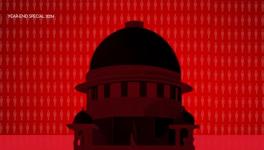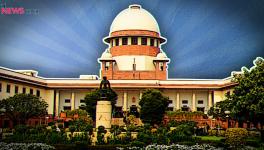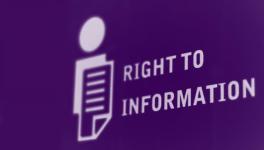Bhopal Gas Tragedy: Forty Years of Struggle For Justice—Part 7

After the Supreme Court upheld the validity of the Bhopal Act on December 22, 1989 [(1990) 1 SCC 613], a Constitution Bench of the Supreme Court proceeded to review the two settlement Orders dated February 14 and 15, 1989 in civil appeal nos. 3187–3188 of 1988 in response to review petition no. 229 of 1989 filed by the Bhopal Gas Peedith Mahila Udyog Sanghathan (BGPMUS), writ petition no. 293 of 1989 filed by the Bhopal Gas Peedith Sangharsh Sahayog Samiti (BGPSSS), and by a few others.
In the judgment delivered on October 3, 1991 [(1991) 4 SCC 584], Justice Venkatachalaiah, who is the author of the judgment, has made a determined effort to defend the indefensible settlement Orders dated February 14 and 15, 1989 [(1989) 1 SCC 674 & 676].
In the said explanatory Order, it was stated that the settlement was based on the assumption that the total human death toll was 3,000.
In the process, the inherent contradictions between the Explanatory Order dated May 4, 1989 [(1989) 3 SCC 38] and the review judgment dated October 3, 1991 are apparent on the face of it.
In the said explanatory Order, it was stated that the settlement was based on the assumption that the total human death toll was 3,000; that victims with injuries of utmost severity were 2,000; seriously injured were 30,000; moderately injured were 20,000; and mildly injured were 50,000. These figures add up to a total of 105,000 gas victims, who formed the basis of the settlement. [pp. 544–545]
However, in the review judgment [(1991) 4 SCC 653 (para127)], the Supreme Court has been forced to admit as follows:
“It would appear that as of October 31, 1990, 639,793 claims had been filed… The results of the medical evaluation and categorisation of the affected persons on the basis of the data entered in their medical folders as on October 31, 1990 are as follows:
No. of medical folders prepared …………………………… 361,966
No. of folders evaluated …………………………………….. 358,712
No. of folders categorised …………………………………... 358,712
No injury ………………………………………………………. 155,203
Temporary injuries …………………………………………… 173,382
Permanent injuries …………………………………………… 18,922
Temporary disablement caused by a temporary injury …. 7,172
Temporary disablement caused by a permanent injury …. 1,313
Permanent partial disablement ……………………………… 2,680
Permanent total disablement ………………………………… 40
Deaths…………………………………………………………… 3,828
[Total dead and injured = 2,07,337]”
[Review judgment dated October 3, 1991, Para 41]
Surprisingly, the review judgment has remained totally silent regarding the implications of these findings although the total figure of dead and injured was far higher than the assumptions on which the settlement was based.
Findings ignored
Surprisingly, the review judgment has remained totally silent regarding the implications of these findings although the total figure of dead and injured was far higher than the assumptions on which the settlement was based.
It may be noted that the so-called medical categorisation exercise was conducted during the period 1987–90, i.e., three to six years after the Bhopal catastrophe purportedly for assessing the degree of injury of each claimant. The possibility that many of the obvious signs of toxic injury may have considerably waned prior to the categorisation exercise was never factored in.
The exercise, which was largely a sham, covered about 361,966 claimants out of the total 639,793 claimants until October 1990. A group of activists prepared a detailed critique of the medical categorisation exercise after carrying out a medical survey in Bhopal in October 1989.
The conclusion of the report, which was titled Against All Odds and prepared by Dr C.Sathyamala [petitioner in writ petition (civil) no. 293 of 1989], Dr Nishit Vohra [petitioner in writ petition (civil) no. 11708 of 1985], and K. Satish was as follows: “By inadequately examining the claimants (clinically and through investigations) and by evaluating the injuries and categorising them with the use of faulty tools biased against the gas victims, the directorate of claims, Bhopal, has ‘defined’ away the injuries of more than 90 percent of the victims as ‘no injury’ or ‘temporary injury’.”
Despite all attempts to grossly underestimate the magnitude and gravity of the impact of the catastrophe, the directorate of claims could not cover up the fact that even as per the so-called medical categorisation exercise, the total number of dead and injured was twice as high as the assumed figures that had formed the basis of the settlement.
The exercise, which was largely a sham, covered about 361,966 claimants out of the total 639,793 claimants until October 1990.
However, a curious aspect was that, while the explanatory Order dated May 4, 1989 has stated that “prima facie undisputed figures” of those who suffered utmost injuries, serious injuries and moderate injuries (avowedly based on hospital records) were at least 52,000 (2000 + 30,000 + 20,000) [Upendra Baxi and Amitha Danda (1990), pp. 544–545], the total in those categories fell to just 30,127 as per the medical categorisation exercise.
How could “prima facie undisputed figures” (avowedly based on hospital records) shrink from 52,000 to just 30,127 unless those figures were doctored? How could hospital records of 22,000 seriously or moderately injured gas victims suddenly disappear unless there was a concerted attempt to consciously minimise the severity of the injuries?
The manner in which “prima facie undisputed figures” have been manipulated is a clear indication that there was a calculated ploy to underplay the gravity of the impact of the catastrophe.
While the gravity of the impact has been stealthily underplayed, the magnitude of the impact of the catastrophe, which was too large, could not be covered up. Even the medical categorisation exercise had to concede that the magnitude of those categorised as suffering from “temporary injuries”/“minor injuries” was 173,382 victims, i.e., three and half times more than the assumed figure at the time of the Settlement, which was just 50,000 victims.
Onus on the Union of India
The net result was Justice Venkatachaliah, the author of the review judgment, while formally applauding the work of the medical categorisation exercise, chose to maintain studied silence regarding its findings.
Instead, realising that the magnitude and gravity of the impact of the catastrophe were actually far greater than the assumed basis of the settlement, he chose to pronounce the following directions: “[I]t is, however, necessary to ensure that in the— perhaps unlikely— event of the settlement-fund being found inadequate to meet the compensation determined in respect of all the present claimants, those persons who may have their claims determined after the fund is exhausted are not left to fend themselves…
“If it should arise, the reasonable way to protect the interests of the victims is to hold that the Union of India, as a welfare State and in the circumstances in which the settlement was made, should not be found wanting in making good the deficiency, if any. We hold and declare accordingly.” [(1991) 4 SCC 584, Para 198]
How could “prima facie undisputed figures” (avowedly based on hospital records) shrink from 52,000 to just 30,127 unless those figures were doctored?
Thus, the entire onus of meeting the shortfall in the settlement fund to adequately compensate all gas victims was shifted onto the shoulders of the Union of India while the guilty company— Union Carbide Corporation— was set free of all such liability.
In the process, the court lent a new meaning to the concept of ‘welfare State’, i.e., a State that is destined to shoulder the burden of liabilities of transnational corporations!
Need for medical surveillance
The court also observed as follows: “On the medical research literature placed before us, it can reasonably be posited that the exposure to such concentrations of MIC might involve delayed manifestations of toxic morbidity.
“The exposed population may not have manifested any immediate symptomatic medical status. But the long latency-period of toxic injuries renders the medical surveillance costs a permissible claim even ultimately the exposed persons may not actually develop the apprehended complications.” [(1991) 4 SCC 584, Para 128]
However, medical surveillance cost was not a factor that was taken into consideration at the time of quantifying the settlement amount. Therefore, in the review judgment, it was further directed as follows: “It will be proper that expert medical facility in the form of the establishment of a full-fledged hospital of at least 500-bed strength with the best of equipment for the treatment of MIC-related affliction should be provided for medical surveillance and for expert medical treatment…
“We hold that the capital outlays on the hospital and its operation expenses for providing free treatment and services to the victims should, both on humanitarian considerations and in fulfillment of the offer made before the Bhopal court, be borne by the UCC and UCIL.” [(1991) 4 SCC 584, Para 203]
The net result was Justice Venkatachaliah, the author of the review judgment, while formally applauding the work of the medical categorisation exercise, chose to maintain studied silence regarding its findings.
Recognition of the need for medical surveillance and expert medical care were very significant directions from the Supreme Court, directions that were rendered in response to the review and writ petitions filed by BGPMUS, BGPSSS and others.
As a result, the UCC was directed to contribute an additional ₹50 crore for that purpose [(1991) 4 SCC 584, para 204], which was a rather paltry sum that was hardly enough to build a 500-bedded hospital with all the necessary super-specialty facilities.
However, the UCC never paid an additional penny and the Supreme Court took no action to compel the UCC to pay the said amount. Ultimately, funds for the hospital were realised through a questionable process— from the sale of the UCC’s shares in the UCIL, which had been attached after the UCC was proclaimed as an absconder in the ongoing criminal case.
Insurance cover
Yet another direction in the review judgment was regarding the need for medical insurance coverage. According to the judgment:
“205. This concerns the exposed members of the populace of Bhopal who were put at risk and who though presently asymptomatic and filed no claims for compensation might become symptomatic in future.
How should cases of yet-unborn children of mothers exposed to MIC toxicity where the children are found to have or develop congenital defects be taken care of?
“206. The question is as to who would provide compensation for such cases?
“207. We are of the view that such contingencies shall be taken care of by obtaining an appropriate medical group insurance cover from the General Insurance Corporation of India or the Life Insurance Corporation of India for compensation to this contingent class of possible prospective victims…
“The number of persons to be covered by this group insurance scheme should be about and not less than one lakh [100,000] of persons… This insurance cover will virtually serve to render the settlement an open-ended one so far as the contingent class of future victims both existing and after-born are concerned. The possible claimants fall into two categories: those who were in existence at the time of exposure [who were initially asymptomatic and had not filed claims]; and those who were yet unborn and whose congenital defects are traceable to MIC toxicity inherited or derived congenitally.” [(1991) 4 SCC 584]
Medical surveillance cost was not a factor that was taken into consideration at the time of quantifying the settlement amount.
However, while no portion of the settlement fund had been earmarked towards payment of insurance premia, the Supreme Court passed the following directions: “The premia for the insurance shall be paid by the Union of India out of the settlement fund.” [(1991) 4 SCC 584, para 209]
A hollow proposition
It has, thus, become evident that the need for insurance cover was not a contingency envisaged under the terms of the settlement but was again arbitrarily incorporated into it without taking any steps to enhance the settlement fund.
While the direction to provide insurance cover was, indeed, a sensible proposition, the failure to enhance the settlement fund in proportion to the required insurance premia to cover 100,000 prospective victims made the court’s direction a completely hollow one.
It may be recalled that the total settlement fund amounted to only US $470 million, which was equivalent to just ₹715 crore at the then exchange rate (US 1$ = ₹15.20).
However, even if 100,000 prospective victims (with an average age of say 30 years) were to be covered by medical insurance for an assured sum of just ₹125,000 each with a policy term of 15 years and premium term of 10 years, the total premia at approximately ₹15,000 per person per year for ten years would have worked out to no less than ₹1,500 crores! [For example, see: LIC’s Bhima Jyoti Plan]
If ₹715 crore was barely enough to award compensation to 105,000 gas victims as per the terms of the settlement, was it not completely absurd on the part of the court to have even suggested that the premia of ₹1,500 crore should be paid out of the settlement fund of Rs.715 crore?
It is, therefore, very apparent that while the court did clearly recognise the need for insurance cover, it desisted from enhancing the settlement fund. The court could have enhanced the settlement fund by placing the onus for payment of the requisite premia on the UCC.
Was there any basis for the court to reach the conclusion that the settlement fund was well-endowed to pay premia for the insurance cover for 100,000 prospective victims? There was no such basis at all!
Since the court— at the time of the settlement— had failed to take into account the claims of future generations of prospective victims born to gas-exposed parent(s).
The court had absolutely no idea if premia could be paid out of the settlement fund. If the court had actually tried to do the necessary calculations, it would have immediately realised that there was no such possibility. In other words, the court’s premise that premia could be paid out of the settlement fund was nothing but an idea that was born out of a figment of imagination.
Since the court— at the time of the settlement— had failed to take into account the claims of future generations of prospective victims born to gas-exposed parent(s), at the time of disposing of the review and writ petitions, it was compelled to take into account the validity of their claims for compensation and had to somehow devise a way to ostensibly render justice.
In effect, the direction to pay premia out of the settlement fund was only a gesture that had the appearance of doing justice; in actual fact, there was no way that premia for their insurance cover could have been paid out of the meagre settlement fund.
Thus, all that the court did was offer false hope of assured compensation to the yet-unborn prospective gas victims. It has to be placed on record that the court did a great disservice to the Bhopal gas victims by failing to hold the UCC squarely responsible for paying the necessary premia for the medical insurance cover.
Requisite tasks
What is significant is that the scope of the proposed medical insurance cover was limited to only those who were present in the gas-affected wards on the day of the disaster but had not yet filed claims (because they were asymptomatic) and to those who were likely to be born [to gas-exposed parent(s)] with birth defects.
[Of course, the insurance cover should also have been extended to all those claimants, who were declared uninjured or only as suffering from minor injuries but whose latent injuries could have manifested as serious injuries at a later stage due to delayed effects.]
Anyway, identifying prospective victims was itself a huge challenge. Until and unless the entire gas-exposed population was placed under medical surveillance, identifying the 100,000 prospective victims, who were eligible for insurance cover, was an impossible task.
In effect, the direction to pay premia out of the settlement fund was only a gesture that had the appearance of doing justice.
In fact, as early as 1985, the Supreme Court, in an Order dated November 4, 1985 in writ petition (civil) no.11708 of 1985 (Nishit Vohra and Ors versus State of MP and Ors) had directed as follows:
“It is desirable that some independent machinery must be set up … [for] carrying out a proper epidemiological survey and also a house-to-house survey of the gas affected victims both of which surveys will also be necessary for the purpose of determining the compensation payable to the gas-affected victims and their families. It would be necessary for the purpose of ensuring proper medical facilities to the gas-affected victims.”
Despite such specific directions from the Supreme Court, till date, neither the Union government nor the state government has paid attention to ensuring that such epidemiological and house-to-house surveys were carried out.
[As has been already pointed out in Part-2 of this series, the house-to-house survey voluntarily undertaken by Tata Institute of Social Sciences (TISS) and nine other schools of social work was summarily aborted by the state government in mid-February 1985 and all the proformas of 25,000 + households remains confiscated till date.]
In the absence of such house-to-house survey and proper medical surveillance, the task of ensuring insurance coverage to 100,000 prospective victims would have remained a mere pipe dream even if funds for the premia for the same had been raised from some other source.
Anyway, proposing insurance cover is one thing but whether the settlement fund was adequate to compensate all the gas victims is altogether another matter, which will be examined in detail in the next part of this article.
Criminal cases revived
A very notable aspect of the review judgment was, of course, the decision to revert that part of the settlement deal— the quashing of criminal cases at the behest of BGPMUS, BGPSSS and others— by passing the following directions: “[W]e hold that the quashing and termination of the criminal proceedings brought about by the Orders dated February 14 and 15, 1989 require to be, and are, hereby reviewed and set aside.” [(1991) 4 SCC 584, para 93]
Other than reviving the criminal cases against all the accused, the review judgment has been very careful not to disturb any of the other terms of the settlement. Instead, the onus of rectifying the inherent defects in the settlement terms was placed on the Union government and the UCC was spared any further “burden”.
Read Part 1 here.
Read Part 2 here.
Read Part 3 here.
Read Part 4 here.
Read Part 5 here.
Read Part 6 here.
Get the latest reports & analysis with people's perspective on Protests, movements & deep analytical videos, discussions of the current affairs in your Telegram app. Subscribe to NewsClick's Telegram channel & get Real-Time updates on stories, as they get published on our website.
























